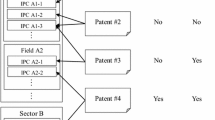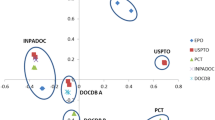Abstract
Convergence is a term that is often used to explain changes in contemporary society, and technological convergence has been an important source of technological innovation in industry. For this paper we adopted a microscopic approach to the question of measuring the level of technological convergence using patent-citation analysis. We developed a convergence indicator that shows the relative convergence degree of a patent. This indicator, which is based on backward and forward patent citations, can assess the extent of the level of convergence or universality. Finally, we conducted an empirical analysis of the cloud computing area using patent-citation analysis from a microscopic perspective.
Similar content being viewed by others
References
Rosenberg N (1963) Technological changes in the machine tool industry, 1840–1910. J Econ Hist 23(4):414–446
Roco MC, Bainbridge WS (eds) (2002) Converging technologies for improving human performance, nanotechnology, biotechnology, information technology and cognitive science. National Science Foundation, Arlington
Nordmann A (2004) Converging technologies—shaping the future of European society. European Commission, Brussels
Hwang JT, Kim BK (2006) Analysis of the multi-technology capabilities of Korea and Taiwan using patent bibliometrics. Asian J Technol Innov 14(2):183–199
Curran CS, Leker J (2010) Patent indicators for monitoring convergence—examples from NFF and ICT. Technol Forecast Soc Change 78(2):256–273. doi:10.1016/j.techfore.2010.06.021
Lee KR (2007) Patterns and processes of contemporary technology fusion: the case of intelligent robots. Asian J Technol Innov 15(2):45–65
No HJ, Park YT (2010) Trajectory patterns of technology fusion: trend analysis and taxonomical grouping in nanobiotechnology. Technol Forecast Soc Change 77(1):63–75. doi:10.1016/j.techfore.2009.06.006
Yoon B, Park Y (2007) Development of a new technology forecasting algorithm—hybrid approach for morphology analysis and conjoint analysis of patent information. IEEE Trans Eng Manag 54(3):588–599
Lind J (2004) Convergence: History of term usage and lessons for firm strategists. In: Proc ITS 15th biennial conf, Berlin, Germany
Kodama F (1991) Analyzing Japanese high technologies: the techno paradigm shift. Pinter, London
Wong PK, Singh A (2005) Technological specialization and convergence of small countries: the case of the late-industrializing Asian NIEs, Development and Comp Systems. EconWPA
Clarkson G, DeKorte D (2006) The problem of patent thickets in convergent technologies. Ann NY Acad Sci 1093:180–200
Wang L, Chen X (2007) Technology convergence in the electronic industry under the FDI environment in China. In: Proc IEEE int conf on wirel commun netw mobile comput (WiCom’07), pp 5831–5834. doi:10.1109/WICOM.2007.1430
Archibugi D (1992) Patenting as an indicator of technological innovation: a review. Sci Public Policy 19(16):357–368
Albert MB, Avery D, Narin F (1991) Direct validation of citation counts as indicators of industrially important patents. Res Policy 20:251–259
Carpenter MP, Narin F, Woolf P (1981) Citation rates of technologically important patents. World Pat Inf 3(5):160–163
Jaffe AB, Trajtenberg M, Fogarty MS (2000) Knowledge spillovers and patent citations: evidence from a survey of inventors. Am Econ Rev 90(2):215–218
Bawa R (2004) Nanotechnology patenting in the US. Nanotechnol Law Bus 1:31–50
Ryu S, Lee K, Mun Y (2010) Optimized fast handover scheme in Mobile IPv6 networks to support mobile users for cloud computing. J Supercomput. doi:10.1007/s11227-010-0459-2
Yoon C, Hassan MM, Lee H, Ryu W, Huh EN (2010) Dynamic collaborative cloud service platform: opportunities and challenges. ETRI J 32(4):634–637. doi:10.4218/etrij.10.0209.0489
Wei G, Vasilakos A-V, Zheng Y, Xiong N (2010) A game-theoretic method of fair resource allocation for cloud computing services. J Supercomput 54(2):252–269. doi:10.1007/s11227-009-0318-1
Author information
Authors and Affiliations
Corresponding author
Rights and permissions
About this article
Cite this article
Sung, K., Kong, HK. & Kim, T. Convergence indicator: the case of cloud computing. J Supercomput 65, 27–37 (2013). https://doi.org/10.1007/s11227-011-0706-1
Published:
Issue Date:
DOI: https://doi.org/10.1007/s11227-011-0706-1




